11 Things to Do in Ushguli, Georgia’s Village of 200 Towers
15 min readYour complete guide to visiting Ushguli, the ‘village of 200 towers’ and a highlight of Georgia’s historic Svaneti Region.
If you’ve come to Georgia searching for dramatic mountains, medieval towers, pastoral landscapes and mythical history, then you are probably searching for Ushguli.
I have been all over the country and I still count Ushguli among the most special places in Georgia. Undoubtedly it is the character-filled defensive koshki towers – which number more than 200 – that help to make the distant past feel closer here than anywhere else.

To call it a village is not quite correct. Ushguli is technically a community of five villages, all pressed into the Patara Enguri River basin in the shadow of Georgia’s highest peak, Mount Shkhara.
Ushguli is one of Georgia’s four UNESCO World Heritage Sites and one of the highest permanent settlements in Europe (it is not the highest, though – that title goes to Bochorma in Tusheti).
Amongst the towers, small museums, churches and some seriously good home-cooked food await visitors. Day hikes, viewpoints, castle ruins and scenic drives are available in the hills beyond.
This quick guide to Ushguli covers the best things to do in 24 hours along with my transport suggestions, accommodation recommendations, and practical travel tips for visiting Ushguli.
More from this series:
- The Ultimate Svaneti Itinerary – how to spend 3-7 Days in Ushguli, Mestia & small villages
- The Best Things to Do in Mestia – a complete guide to Svaneti’s biggest town (coming soon)


Please note: This post contains affiliate links, meaning I may earn a commission if you make a purchase by clicking a link (at no extra cost to you). Learn more.
Tourist map of Ushguli

11 spectacular things to do in Ushguli
1. Walk amongst the ancient koshki towers in Chazhashi

Defensive tower-dwellings can be found all across the highland regions of Georgia, including in Khevsureti and Tusheti. None are more celebrated than Svaneti’s stone towers, known as koshki. They give this area its mystical aura and are without a doubt Ushguli’s main draw.
Chazhashi village has the highest concentration of medieval towers and should be your first stop when arriving in Ushguli. Upper Svaneti’s UNESCO Listing (1996) names Chazhashi specifically, noting that there are more than 200 koshki towers spread across its four settlements.
Most of the tapered koshki were constructed between the 9th and 12th centuries. Some have been repaired or added to over the centuries, while others wobble on their original footings or have crumbled away.
The towers are privately owned and have been passed down through the generations. One of them, Nizharadze Tower, bears a plaque emblazoned with the family name.


The narrow streets in the lower part of Chazhashi have a particularly lovely array of towers. There are several that you can summit for a small fee, plus a small tower museum.
After winding through the backstreets, you can climb up to the Chazhashi Church of the Saviour, which is raised on a hillock above the village. (Just take care on the metal staircase – I slipped over when I had to duck under the arch and wound up with a nasty bruise!)

The pathway alongside the church will take you up to Queen Tamar’s Tower, see #2 below.
2. Get a view from Queen Tamar’s Tower

The most quintessential view of Ushguli – that panorama of towers and hollowed-out stone foundations sprawled across the river valley, fading out into the mountains – is available from the foot of Queen Tamar’s Tower.
Named in honour of the woman who reigned over Georgia during its Golden Age, this tower is unlike most others. It did not belong to a single family, but was rather used by the entire community. Known as a Supar meaning ‘gathering place’ in Svan language, this is the spot where community representatives would gather to discuss important issues and make decisions, not unlike Sabcheo courts in Dartlo and other parts of Tusheti.

On the back side of the tower there is a small memorial plaque dedicated to the heroes of the Great Patriotic War. The fact that it bears just four faces is a reminder of how small a community Ushguli is – only 70 families, or approximately 200-300 people, live here permanently.
Adjacent to the tower, the Church of St. George of Chazhashi is a tiny chapel with a beautifully carved door.


It is not possible to climb the tower, but its elevated position affords a great view from ground level. To the west, you look directly over Chazhashi village and the lower Murkmeli village (see #9 below). Looking back to the east, you can see the upper villages of Chvibiani, Zhibiani and Lamjurishi with Shkhara in the distance.
In summer and autumn, the best light for photos comes during the mid-morning.
3. Hike to Queen Tamar’s Castle

Also connected to Queen Tamar, this castle sits on the mountainside high above Chazhashi village, and is the first thing you see when arriving in Ushguli from Mestia. One of four documented medieval ruins in the area, the castle is believed to have been used by Tamar and her court as a summer residence.
The hike to the top starts from the little footbridge in Chazhashi. The trail is unmarked and difficult to follow in places, so I plotted it myself here on Wikiloc. It only takes 40 minutes or so to reach the ruins, but be warned that the path follows a dry-ish river bed and is extremely steep, uneven and slippery. I would not attempt this walk during or after heavy rain.
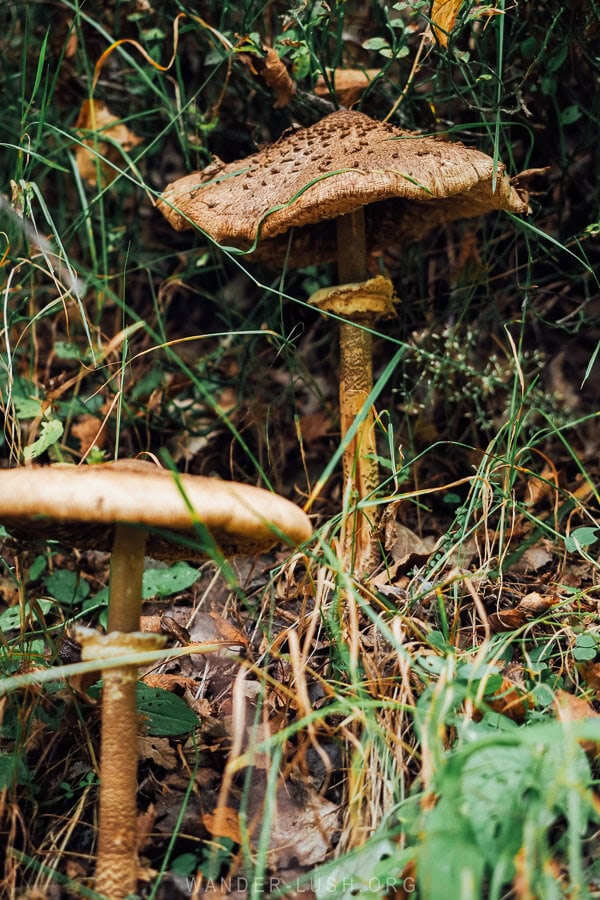
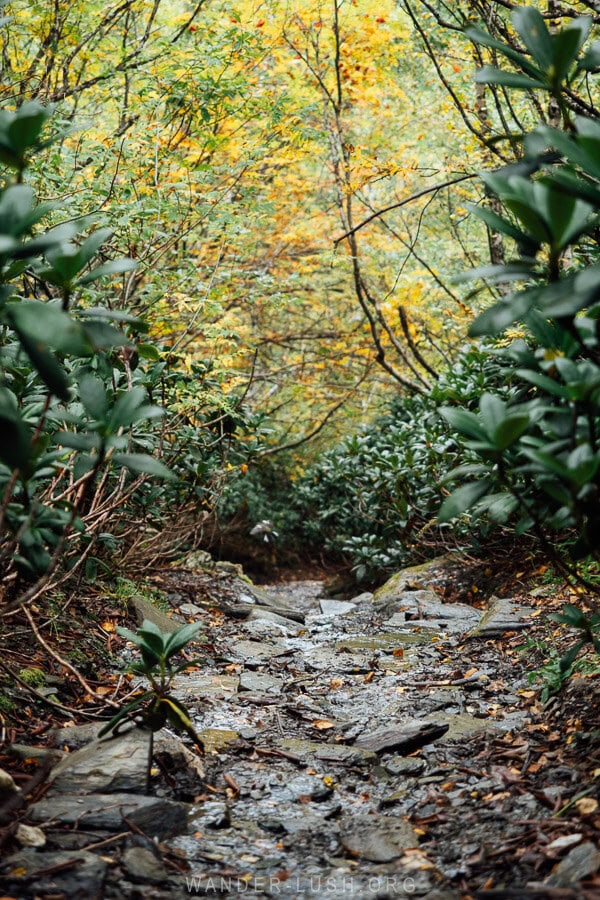
The castle sits on the edge of a ridge. When you reach the stone walls, you enter into the internal courtyard via a small opening. This reminded me a lot of the entrance to the megalithic Shaori Fortress in Samtskhe-Javakheti.
The ruins are in pretty bad shape – we saw some wooden planks rigged to the tower to gain entrance to the walls and upper storeys. We didn’t dare try to get up there! As you wander around, you will notice that someone has erected a tiny altar in one of the rock niches.


It was very cloudy on the morning of our visit, so we missed the best part of the view down over Ushguli and west along the river valley.
Still, this short walk was a big adventure and ended up being one of the highlights of Ushguli for me. We only encountered one other pair of travellers on the trail.
4. Make a pilgrimage to Lamaria Church
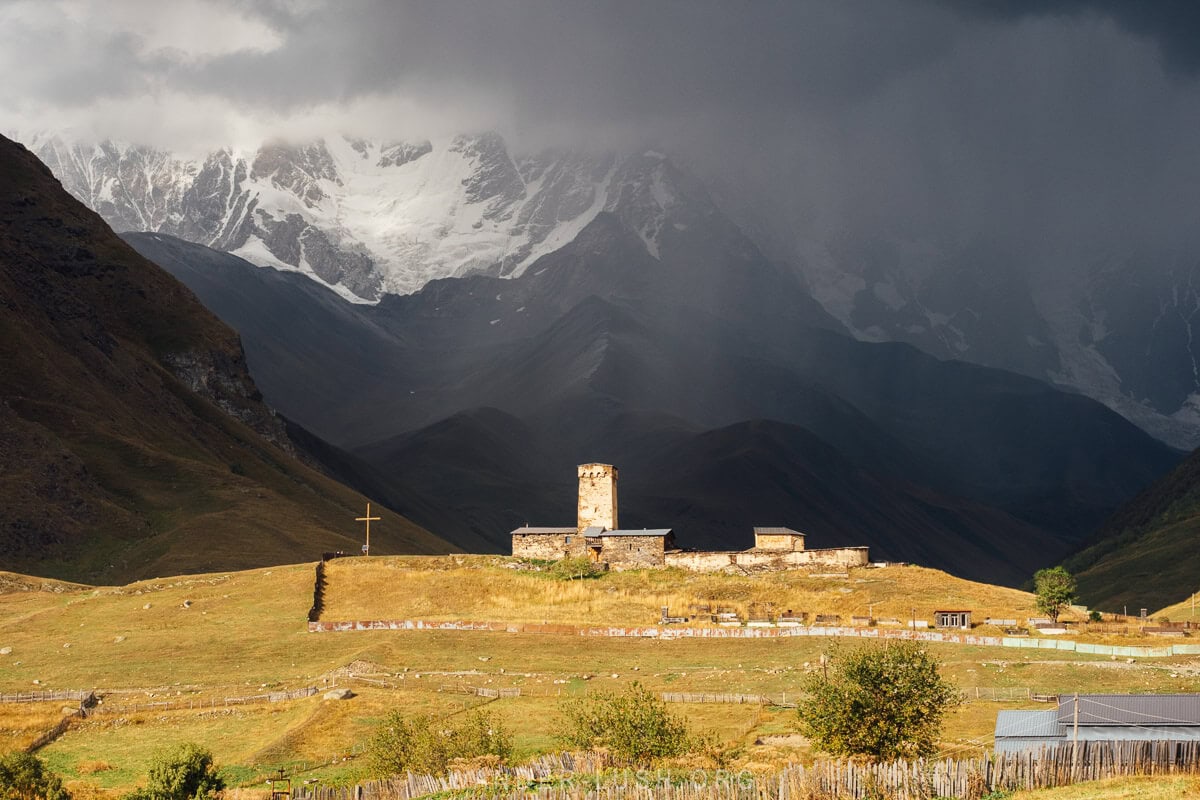
Lamaria Church is the symbol of Svaneti Region. It sits on a rocky plateau in the upper part of the community with snow-striped Shkhara as its stageset.
On your way up, be sure to stop off in the village to view the church from afar – it cuts a stunning figure, particularly against a moody sky (as pictured above).

A series of one-storey stone buildings nestled around a koshki tower, the church dates to the 11th or 12th century and illustrates the layering of pagan and Orthodox traditions common in Georgia’s highlands. The church is dedicated to the Svan Goddess Lamaria, who is associated with the grain harvest, cattle, and fertility in general.
Access to the church is from the north-eastern side via a steep road (by car) or alternatively via a footpath cut from the southwestern hillside. Push open the gate to enter the compound. Before entering the sanctuary, women should cover their hair using one of the scarves available at the door.

Inside, the church’s main altar covering is carved from stone and embellished with icons and an embroidered curtain. Faded ochre-coloured frescoes can be seen in the dark passageways that branch off the main sanctuary to a series of smaller altars.


During our visit, we had to stand back as a couple hurriedly lit votive candles in between fielding phone calls. Perhaps the arrival of a new family member was imminent… The deity Lamaria is connected to the Virgin Mary and considered to be a protector of women during childbirth.
In the northern corner of the churchyard you will see a huge iron pot used for preparing sacrificial feasts. More examples and an explanation of this Svan tradition can be found at the Ethnography Museum in Mestia.
5. Watch the sunset (and the sunrise) over Georgia’s highest peak

This unassuming viewpoint was probably the highlight of our visit to Ushguli. We went up for the sunset (or more accurately, blue hour) on our first night then returned the next morning for the sunrise. The vista is that good!
Marked on Google Maps as the Enguri Valley Viewpoint (see my Ushguli Map for the exact location), it is essentially a little flat plateau on top of a hill off the road near Lamaria Church. There is a clear dirt track that you can either walk or drive. We managed it just fine in our RAV4 and saw a sedan up there, too – just note that there are a few big rocks to avoid at the top.
Looking towards the north-east, you get a full panorama of the Patara Enguri River Valley towards Georgia’s highest peak, Shkhara. The 5,193-metre-high mountain doesn’t look all that tall – probably because you are already at an elevation of 2,100 metres in Ushguli. The rippled mountain face, gradient hills and glimmering river combine for a breathtaking scene.


I personally preferred the light and colours at sunrise (above right) compared to sunset (above left). Shkhara is habitually shrouded in clouds (much like Mount Kazbek in Stepantsminda), but we were lucky enough to get a crystal clear view. If you want to catch the rising sun creeping through the valley, I recommend arriving roughly an hour after sunrise (the sun takes a little longer to appear over the high mountains).
If you are camping or overlanding in a van, there is a relatively private marked camping spot on the side of the river directly below the viewpoint that surely commands a great view.
6. Wander through picturesque Chvibiani
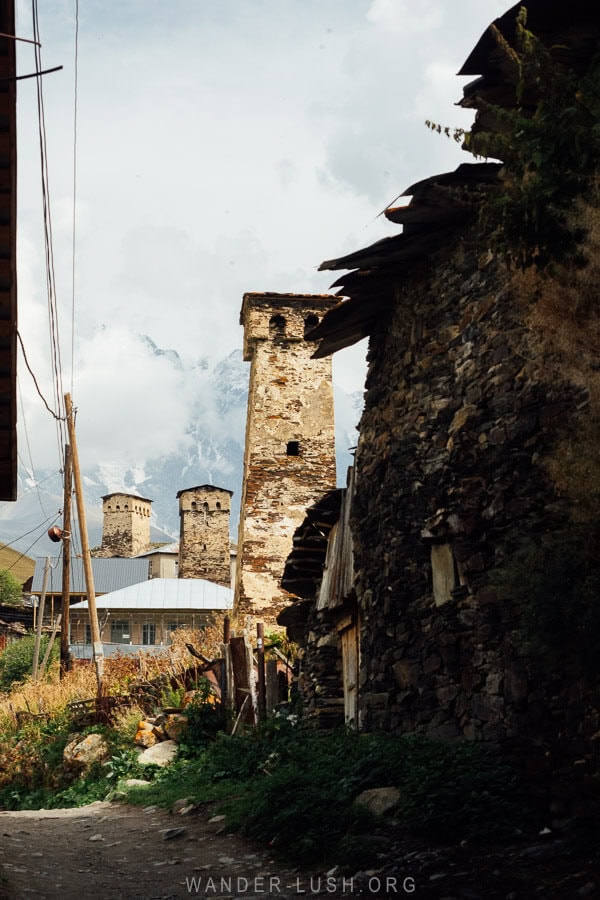

Chvibiani sits below Lamaria Church in the upper part of Ushguli. This village is extremely picturesque, with a combination of towers and timber houses arranged along narrow lanes. The main street that runs perpendicular to the Patara Enguri River is one of my favourite photo spots in Ushguli. A perfect line of handsome towers reveals itself when you look eastward.
In this area, you will find a small movie house, Cinema Dede, that loops the Dede film famously set and shot in Ushguli every day at 1pm, 3pm, 5pm, 7pm and 9pm. The tiny Chvibiani Church is also located here, along with Ushguli’s Ethnographic Museum (see #7 below) and some terrific restaurants (see #8 below).
There are a few small shops set up on this street, selling Svan salt, homemade biscuits and wool socks.
7. Tour Ushguli’s tiny ethnographic museum


There are two museums in Ushguli. The tower museum in Chazhashi (incorrectly pinned on Google Maps and actually located here) was closed every time we walked past. We opted to visit the ‘Ushguli Museum’, located here in Chvibiani, instead.
This is a small museum by any measure. It follows the same format as most house-museums in Svaneti: it is set up like a family’s living space would have been in the past, with everyday objects and artefacts arranged on the floors and on shelves. According to the signage, this tower was inhabited by a family of 10 people up until 1950.
Didactics are limited, but some items have English-language labels. Some reviews on Google speak of a guided tour, but staff were not interested in showing me around, unfortunately.
This museum’s collection of wood carvings is quite something and definitely the highlight of the exhibition. There is also a nice set of archival photographs of old Ushguli.
Though not a must-see, it is worth stopping for if you are walking by and find the door open. Entrance costs 10 GEL (cash only).
8. Indulge in Svan cuisine & traditional herbal tea


I was very impressed by the foodie scene in Mestia – but for good old-fashioned home cooking, nothing could beat the small family-run cafes in Ushguli.
My two favourites are both located in Chvibiani. Cafe Restaurant Murkvam has a unique setting inside a historic stone house. We had the best kubdari (Svan meat pie) of our trip here (above left), and rounded-out our lunch with a delicious dessert of housemade matsoni yogurt with berry jam (above right).
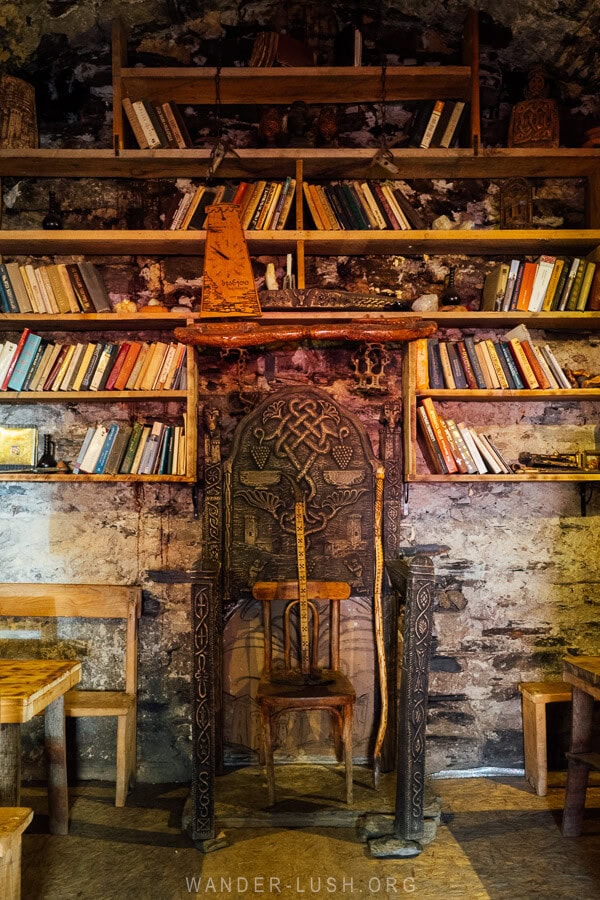

A little further up the road, Cafe Svaneti is a simple establishment with its menu written on pieces of scrap wood (I love that!). Their meat soup is garlicky and nourishing, and the shoti bread and khachapuri are made fresh to order on a little stove.
The two ladies running the joint are very sweet.

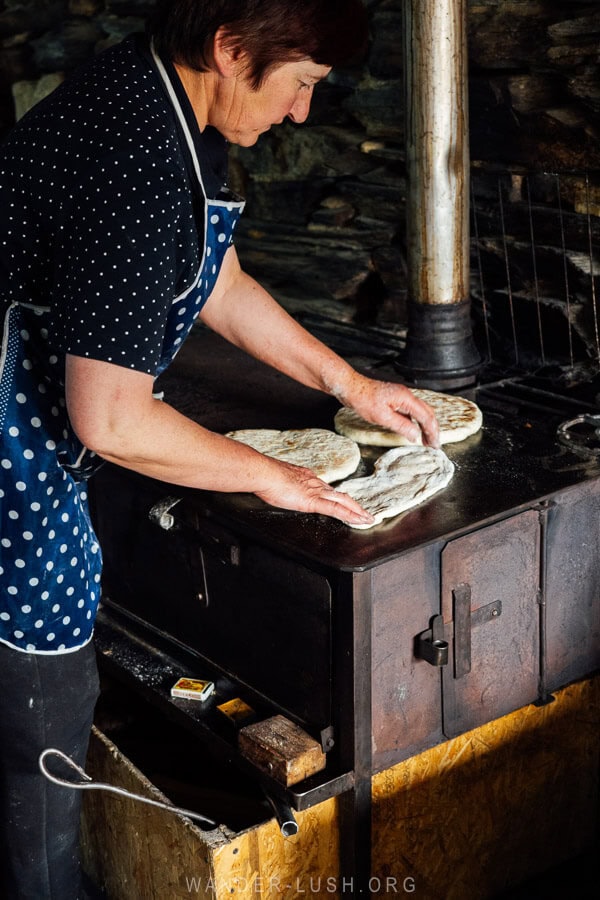
Cafe Shumeri in Zhibani is another solid restaurant and a good option for breakfast (I don’t know what was in the omelette, but boy was it delicious). They also serve Svan flower tea, which is just the thing on a cold Ushguli evening.
We arrived one night to grab a cup of tea and had to wait for the owner to finish milking her cow before she could serve us. This cafe is conveniently within walking distance of Guesthouse Angelina, my preferred accommodation in Ushguli.
9. Stop by Murkmeli & Matskhovari Church
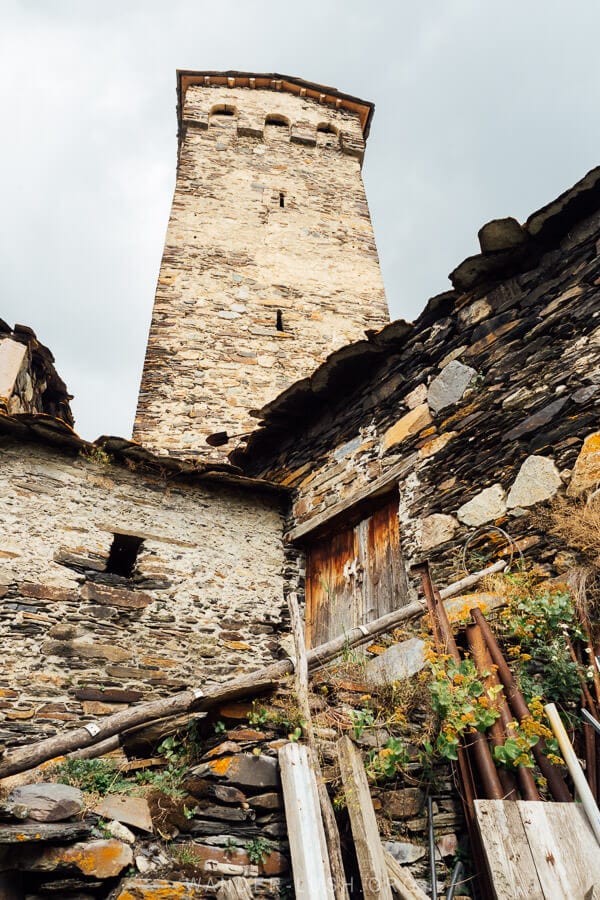

Murkmeli is the lowest village and the first community you encounter upon entering Ushguli. The tiny cluster of houses and towers is separated from Chazhashi and somehow feels even more remote than the rest of the community.
The towers in this village are in a particularly bad state. The small Matskhovari Church sits behind someone’s garden fence – we asked the family if we could take a look, and they kindly agreed.
For reference, walking from the highest part of Ushguli (from Lamaria Church) to the lowest point in Matskhovari takes around 30-45 minutes.
10. Hike to Shkhara Glacier or Romisghele Lake

There are several day hikes available from Ushguli. The most popular is the hike to the foot of Georgia’s tallest peak and the Shkhara Glacier. A marked and well-trod trail follows the Enguri River Valley floor and is mostly flat, taking 5-6 hours on average to complete. You can shorten the hike by driving deeper into the valley – but I am unsure of the road conditions.
Find the route here on Alltrails.
The hike to Romisghele Lake starts by following the same route along the valley before branching off to the east. After trekking through wildflower meadows, you will be met by views of Shkhara reflected back in the glassy water. This hike takes around 3 hours.
Find a trail description and map here on Wikiloc.
At the time of our visit, there were a lot of cement trucks kicking up dust on the road into the river valley, so we decided to skip these particular hikes. Hopefully the road will be quieter in spring/summer 2025.
11. Drive the new road over the Zagari Pass to Lentekhi & Kutaisi

The road between Ushguli and Lower Svaneti is an attraction in and of itself. Its highest point, the Zagari Pass (2,620 metres above sea level), traverses Svaneti and Racha-Lechkhumi Region, offering some of the most spectacular high mountain scenery this side of the Greater Caucasus.
Previously this was a popular route for offroading. Thanks to extensive roadworks that took place over the summer/autumn of 2024, a new concrete road makes the area accessible to any type of vehicle.
When we travelled in September, there were several short stretches of compacted gravel with work actively ongoing. By the time you read this, those sections would likely have been sealed.
The drive to Kutaisi from Ushguli takes around 4 hours. The road ranges from open, wide sections cut between the high mountains to narrow, winding tracks hemmed in by gigantic rock walls. The most spectacular section comes directly after the Zagari Pass, when you follow a set of switchbacks into Koruldashi. It’s as if you are driving right into the mouth of the glacier.
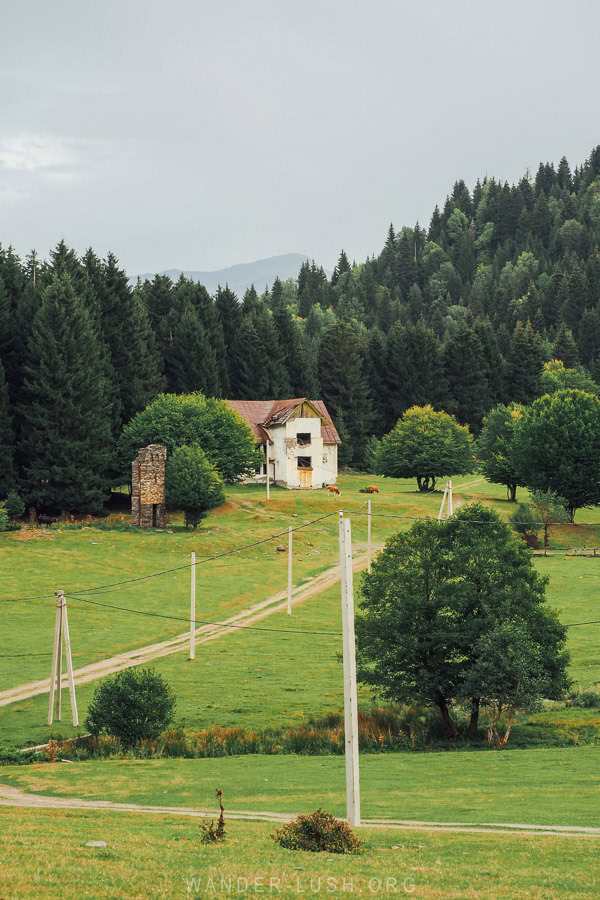

The pass takes you down into Lower Svaneti, a world away from Upper Svaneti and a wholly underrated and lesser-explored part of Georgia. Lentekhi is well worth a stopover. I recommend staying at JorJ’Inn in Sasashi village and visiting Muashi, a former summer camp/resort with curative mineral water springs.
If you’re into urbexing, you will find Muashi’s unusual bath house building and crumbling cottages (pictured above) very enigmatic.
Ushguli travel guide
When is the best time to visit Ushguli?
Given its elevation, summer is the best time to visit Ushguli, specifically the months of July, August and September.
Even though the sealed road from Mestia is maintained throughout the winter, conditions can be difficult and transport options are more limited. The new road from Kutaisi to Ushguli will not be cleared this winter.
Most guesthouses in Ushguli close for the winter season. Those that remain open might not have central heating. Hiking is of course off the cards in winter.

July and August mark the peak of the hiking season and are the busiest months in Svaneti. If you are planning to do the Mestia-Ushguli Trek, you will absolutely need to pre-book your accommodation.
September (and perhaps the first weeks of October, weather depending) are comparatively quieter. You can find beautiful fall colours in the highlands at this time of year.
My first trip to Ushguli was in May, and most recently I travelled in early September. Autumn is definitely my preference – the weather is drier and the vibe is generally more upbeat at the tailend of summer compared to the beginning of the season.
How long should you spend in Ushguli?
Most travellers visit Ushguli as a day trip from Mestia. The new road has reduced travel time between the two villages to 90 minutes or less (one-way), which does mean you get more time in Ushguli than you did before. (When I first visited Ushguli in 2017, the drive took twice as long.)
If you have limited time in Svaneti, it is possible to see the highlights within the 4-5 hour timeframe you are given on a standard shared transfer. If you want to explore all the villages and do a bit of hiking, you should plan to spend at least one night in Ushguli.
We found 24 hours (an afternoon plus an evening and a morning) the perfect amount of time for Ushguli. Sunset/sunrise is quite spectacular, which is a compelling reason to overnight here if you can (see #5 above).
How to get to Ushguli
There are two ways to reach Ushguli: Via Mestia and Zugdidi (the established route), or via Lentekhi and Kutaisi (the new route).
Marshrutka vans still follow the established route via Mestia. Private drivers and shared vans are in no short supply, with departures throughout the morning from Mestia’s bus station area. The going rate is 40-60 GEL per person.
For full details and travel tips, see my Mestia public transport guide.


The new route between Kutaisi and Ushguli is an option as of autumn 2024. The road is concrete, and does not require a 4WD or any offroading experience. Unfortunately most car rental companies have not updated their T&Cs and will not allow you to drive on this road. I expect this will change by next summer – and I also expect marshrutka vans will become available. Travel time from Kutaisi to Ushguli by car is approximately 4 hours.
For full details about the new road, see my Svaneti road trip guide.
Where to stay in Ushguli
The number of guesthouses in Ushguli has exploded over the past five years. Compared to Mestia where you can find some nice boutique hotels and ski lodges, most accommodations in Ushguli are fairly basic. Shared bathrooms are the norm.
If you have a car, I highly recommend staying in one of the upper villages (Zhibani is probably the best option) where the roads are wider and there is more parking available.
We were very happy with our decision to stay at Guesthouse Angelina in Zhibani. The house is warm and clean, and the view of Lamaria Church from our bedroom window was absolutely priceless.


Other popular and well-rated guesthouses include Nizharadze’s Tower, Mshvidoba and Old House. Note that some properties close for bookings in October and reopen in spring.
6 quick travel tips for Ushguli
1. There are no ATMs in Ushguli. The closest ATM is in Mestia. Some restaurants have a card terminal, but cash is still king in Ushguli, including at guesthouses, so make sure you bring plenty of GEL with you.
2. If you have a Magti SIM card, you will have no trouble getting online in Ushguli. Coverage is limited outside the village centre, so be sure to download offline maps for any hikes. Most guesthouses have free WIFI. There is no Magti shop.
3. There are very few shops in Ushguli, and those that do exist have inflated prices. Bring any supplies you might need with you from Mestia, where there is a range of convenience stores and markets.
4. It is perfectly safe to drink tap water in Ushguli. Savour the fresh, clean mountain spring water! If you are hiking in Ushguli, make sure you research your route for water sources and bring plenty of drinking water with you if required.
5. Parking is limited in some parts of Ushguli, particularly in Chvibiani and Murkmeli. Some of the roads are very narrow and steep. If you are driving, stick to the main thoroughfares. It’s a good idea to park at your guesthouse and explore by foot.
6. Ushguli is a safe travel destination, but you should always exercise common sense. Avoid hiking alone. As with all rural locations in Georgia, it’s a good idea to dress and behave modestly.



